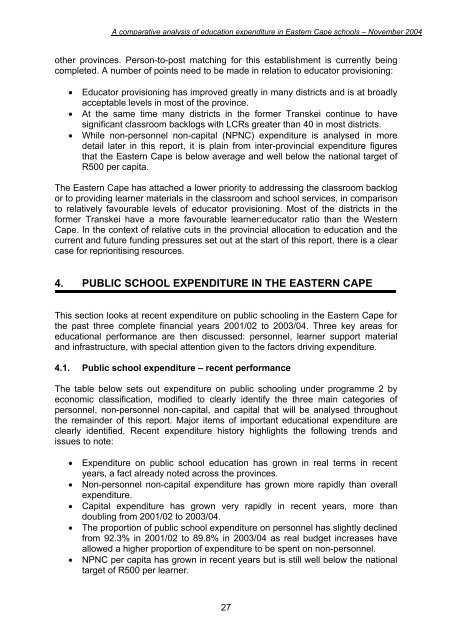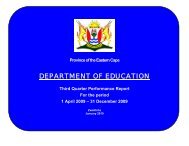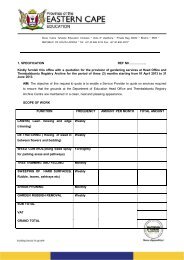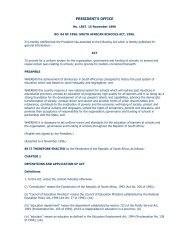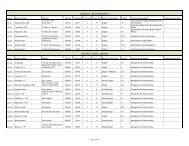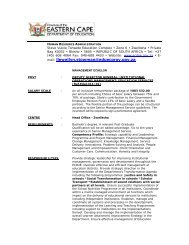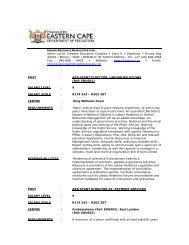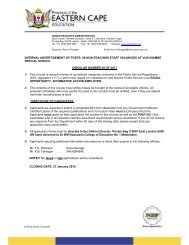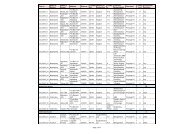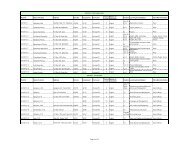School Community Integration Pilot Project - Department of Education
School Community Integration Pilot Project - Department of Education
School Community Integration Pilot Project - Department of Education
Create successful ePaper yourself
Turn your PDF publications into a flip-book with our unique Google optimized e-Paper software.
A comparative analysis <strong>of</strong> education expenditure in Eastern Cape schools – November 2004<br />
other provinces. Person-to-post matching for this establishment is currently being<br />
completed. A number <strong>of</strong> points need to be made in relation to educator provisioning:<br />
• Educator provisioning has improved greatly in many districts and is at broadly<br />
acceptable levels in most <strong>of</strong> the province.<br />
• At the same time many districts in the former Transkei continue to have<br />
significant classroom backlogs with LCRs greater than 40 in most districts.<br />
• While non-personnel non-capital (NPNC) expenditure is analysed in more<br />
detail later in this report, it is plain from inter-provincial expenditure figures<br />
that the Eastern Cape is below average and well below the national target <strong>of</strong><br />
R500 per capita.<br />
The Eastern Cape has attached a lower priority to addressing the classroom backlog<br />
or to providing learner materials in the classroom and school services, in comparison<br />
to relatively favourable levels <strong>of</strong> educator provisioning. Most <strong>of</strong> the districts in the<br />
former Transkei have a more favourable learner:educator ratio than the Western<br />
Cape. In the context <strong>of</strong> relative cuts in the provincial allocation to education and the<br />
current and future funding pressures set out at the start <strong>of</strong> this report, there is a clear<br />
case for reprioritising resources.<br />
4. PUBLIC SCHOOL EXPENDITURE IN THE EASTERN CAPE<br />
This section looks at recent expenditure on public schooling in the Eastern Cape for<br />
the past three complete financial years 2001/02 to 2003/04. Three key areas for<br />
educational performance are then discussed: personnel, learner support material<br />
and infrastructure, with special attention given to the factors driving expenditure.<br />
4.1. Public school expenditure – recent performance<br />
The table below sets out expenditure on public schooling under programme 2 by<br />
economic classification, modified to clearly identify the three main categories <strong>of</strong><br />
personnel, non-personnel non-capital, and capital that will be analysed throughout<br />
the remainder <strong>of</strong> this report. Major items <strong>of</strong> important educational expenditure are<br />
clearly identified. Recent expenditure history highlights the following trends and<br />
issues to note:<br />
• Expenditure on public school education has grown in real terms in recent<br />
years, a fact already noted across the provinces.<br />
• Non-personnel non-capital expenditure has grown more rapidly than overall<br />
expenditure.<br />
• Capital expenditure has grown very rapidly in recent years, more than<br />
doubling from 2001/02 to 2003/04.<br />
• The proportion <strong>of</strong> public school expenditure on personnel has slightly declined<br />
from 92.3% in 2001/02 to 89.8% in 2003/04 as real budget increases have<br />
allowed a higher proportion <strong>of</strong> expenditure to be spent on non-personnel.<br />
• NPNC per capita has grown in recent years but is still well below the national<br />
target <strong>of</strong> R500 per learner.<br />
27


